Principles of Macroeconomics | Document
VerifiedAdded on 2022/08/21
|13
|2643
|11
AI Summary
2 short term economic challenges and one long term challenge 3 recommended policies Used of graph 9 references (including OECD report)
Contribute Materials
Your contribution can guide someone’s learning journey. Share your
documents today.
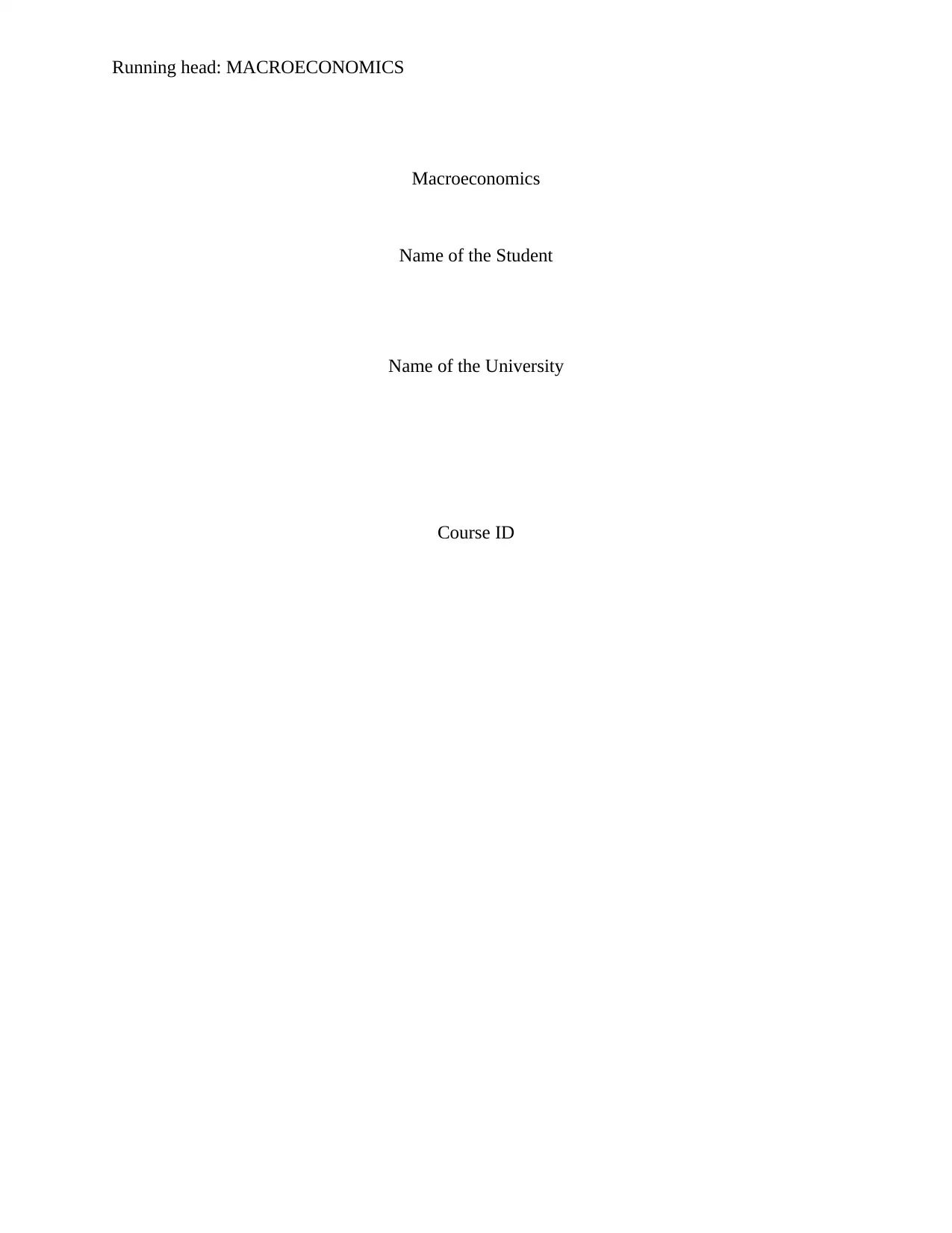
Running head: MACROECONOMICS
Macroeconomics
Name of the Student
Name of the University
Course ID
Macroeconomics
Name of the Student
Name of the University
Course ID
Secure Best Marks with AI Grader
Need help grading? Try our AI Grader for instant feedback on your assignments.
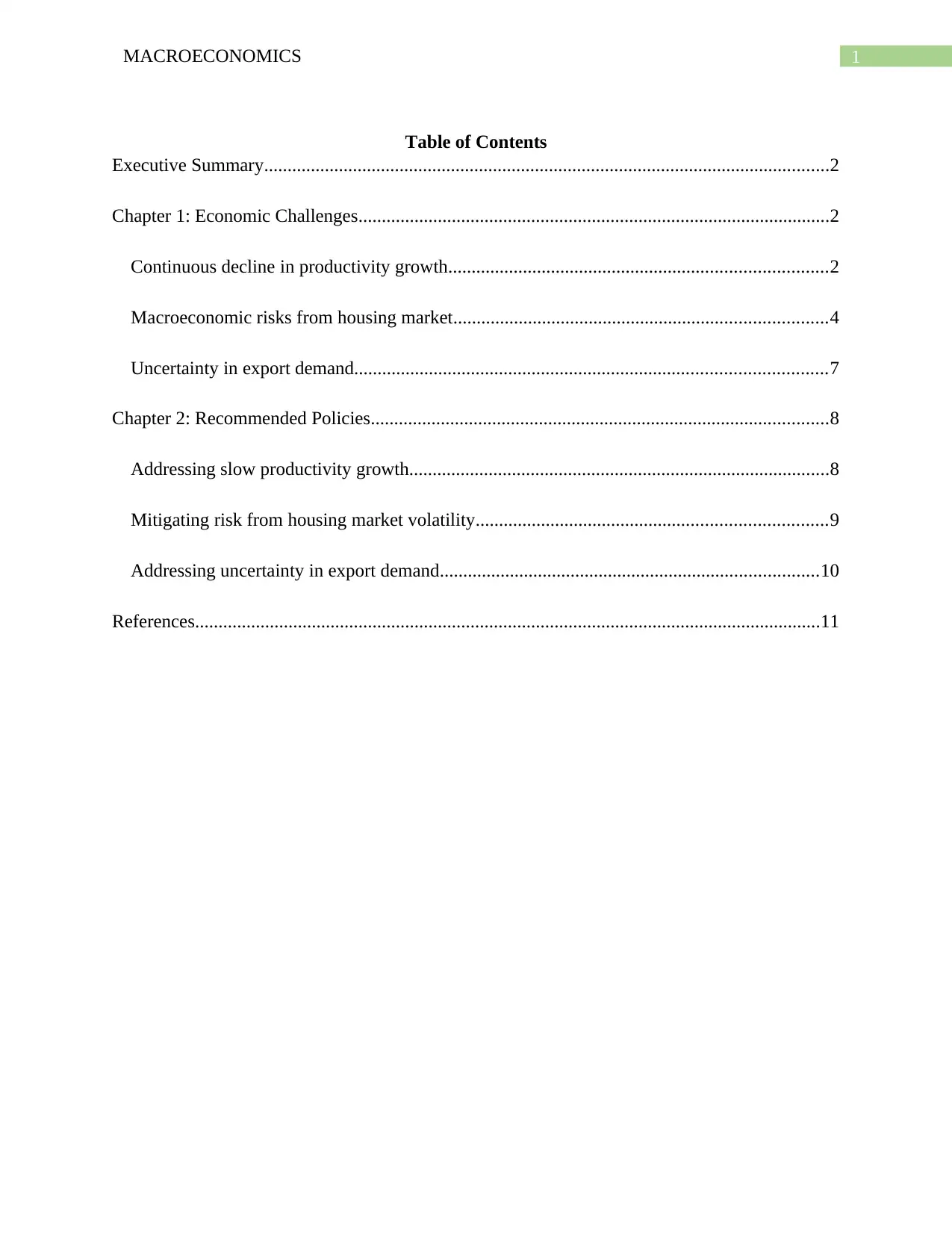
1MACROECONOMICS
Table of Contents
Executive Summary.........................................................................................................................2
Chapter 1: Economic Challenges.....................................................................................................2
Continuous decline in productivity growth.................................................................................2
Macroeconomic risks from housing market................................................................................4
Uncertainty in export demand.....................................................................................................7
Chapter 2: Recommended Policies..................................................................................................8
Addressing slow productivity growth..........................................................................................8
Mitigating risk from housing market volatility...........................................................................9
Addressing uncertainty in export demand.................................................................................10
References......................................................................................................................................11
Table of Contents
Executive Summary.........................................................................................................................2
Chapter 1: Economic Challenges.....................................................................................................2
Continuous decline in productivity growth.................................................................................2
Macroeconomic risks from housing market................................................................................4
Uncertainty in export demand.....................................................................................................7
Chapter 2: Recommended Policies..................................................................................................8
Addressing slow productivity growth..........................................................................................8
Mitigating risk from housing market volatility...........................................................................9
Addressing uncertainty in export demand.................................................................................10
References......................................................................................................................................11
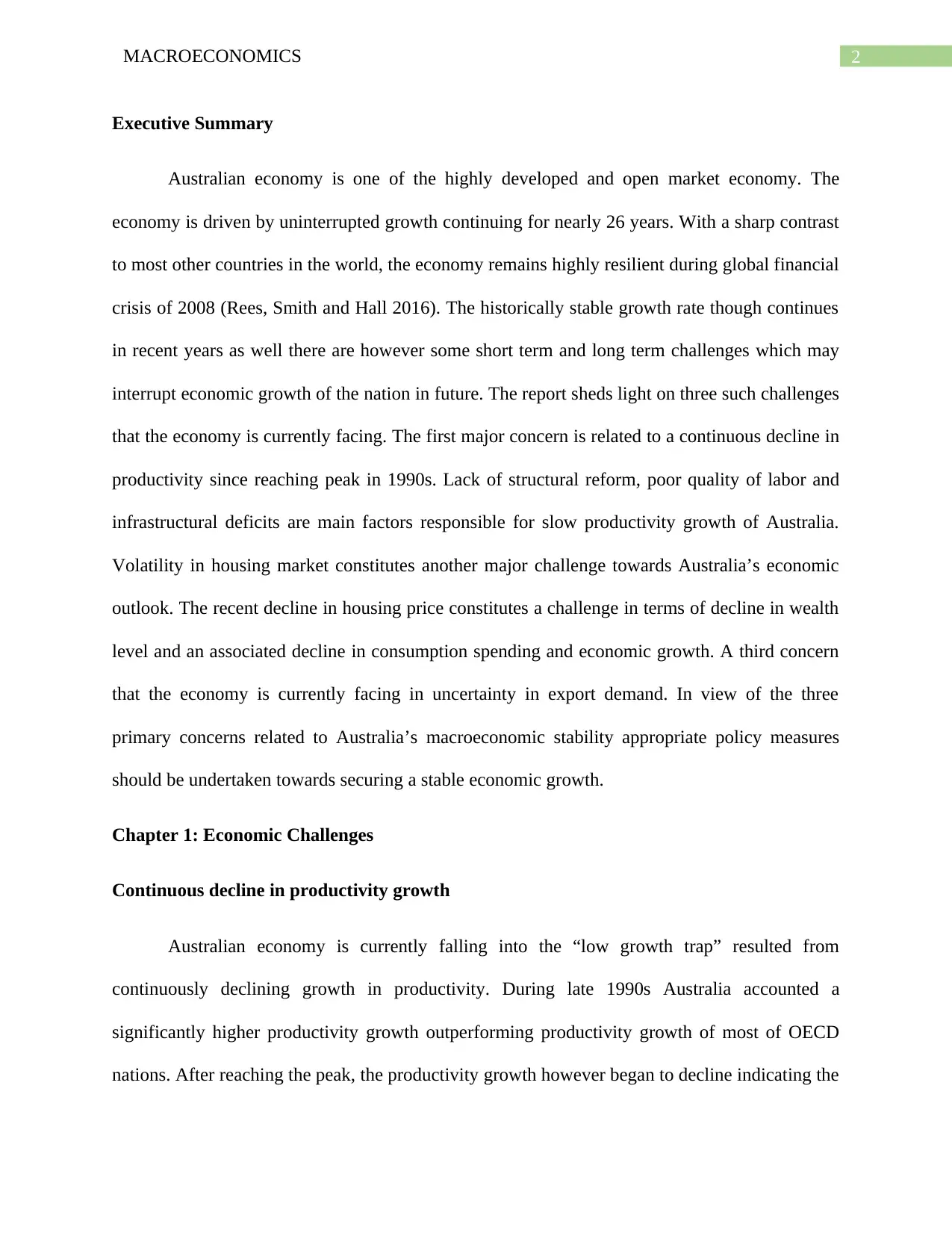
2MACROECONOMICS
Executive Summary
Australian economy is one of the highly developed and open market economy. The
economy is driven by uninterrupted growth continuing for nearly 26 years. With a sharp contrast
to most other countries in the world, the economy remains highly resilient during global financial
crisis of 2008 (Rees, Smith and Hall 2016). The historically stable growth rate though continues
in recent years as well there are however some short term and long term challenges which may
interrupt economic growth of the nation in future. The report sheds light on three such challenges
that the economy is currently facing. The first major concern is related to a continuous decline in
productivity since reaching peak in 1990s. Lack of structural reform, poor quality of labor and
infrastructural deficits are main factors responsible for slow productivity growth of Australia.
Volatility in housing market constitutes another major challenge towards Australia’s economic
outlook. The recent decline in housing price constitutes a challenge in terms of decline in wealth
level and an associated decline in consumption spending and economic growth. A third concern
that the economy is currently facing in uncertainty in export demand. In view of the three
primary concerns related to Australia’s macroeconomic stability appropriate policy measures
should be undertaken towards securing a stable economic growth.
Chapter 1: Economic Challenges
Continuous decline in productivity growth
Australian economy is currently falling into the “low growth trap” resulted from
continuously declining growth in productivity. During late 1990s Australia accounted a
significantly higher productivity growth outperforming productivity growth of most of OECD
nations. After reaching the peak, the productivity growth however began to decline indicating the
Executive Summary
Australian economy is one of the highly developed and open market economy. The
economy is driven by uninterrupted growth continuing for nearly 26 years. With a sharp contrast
to most other countries in the world, the economy remains highly resilient during global financial
crisis of 2008 (Rees, Smith and Hall 2016). The historically stable growth rate though continues
in recent years as well there are however some short term and long term challenges which may
interrupt economic growth of the nation in future. The report sheds light on three such challenges
that the economy is currently facing. The first major concern is related to a continuous decline in
productivity since reaching peak in 1990s. Lack of structural reform, poor quality of labor and
infrastructural deficits are main factors responsible for slow productivity growth of Australia.
Volatility in housing market constitutes another major challenge towards Australia’s economic
outlook. The recent decline in housing price constitutes a challenge in terms of decline in wealth
level and an associated decline in consumption spending and economic growth. A third concern
that the economy is currently facing in uncertainty in export demand. In view of the three
primary concerns related to Australia’s macroeconomic stability appropriate policy measures
should be undertaken towards securing a stable economic growth.
Chapter 1: Economic Challenges
Continuous decline in productivity growth
Australian economy is currently falling into the “low growth trap” resulted from
continuously declining growth in productivity. During late 1990s Australia accounted a
significantly higher productivity growth outperforming productivity growth of most of OECD
nations. After reaching the peak, the productivity growth however began to decline indicating the
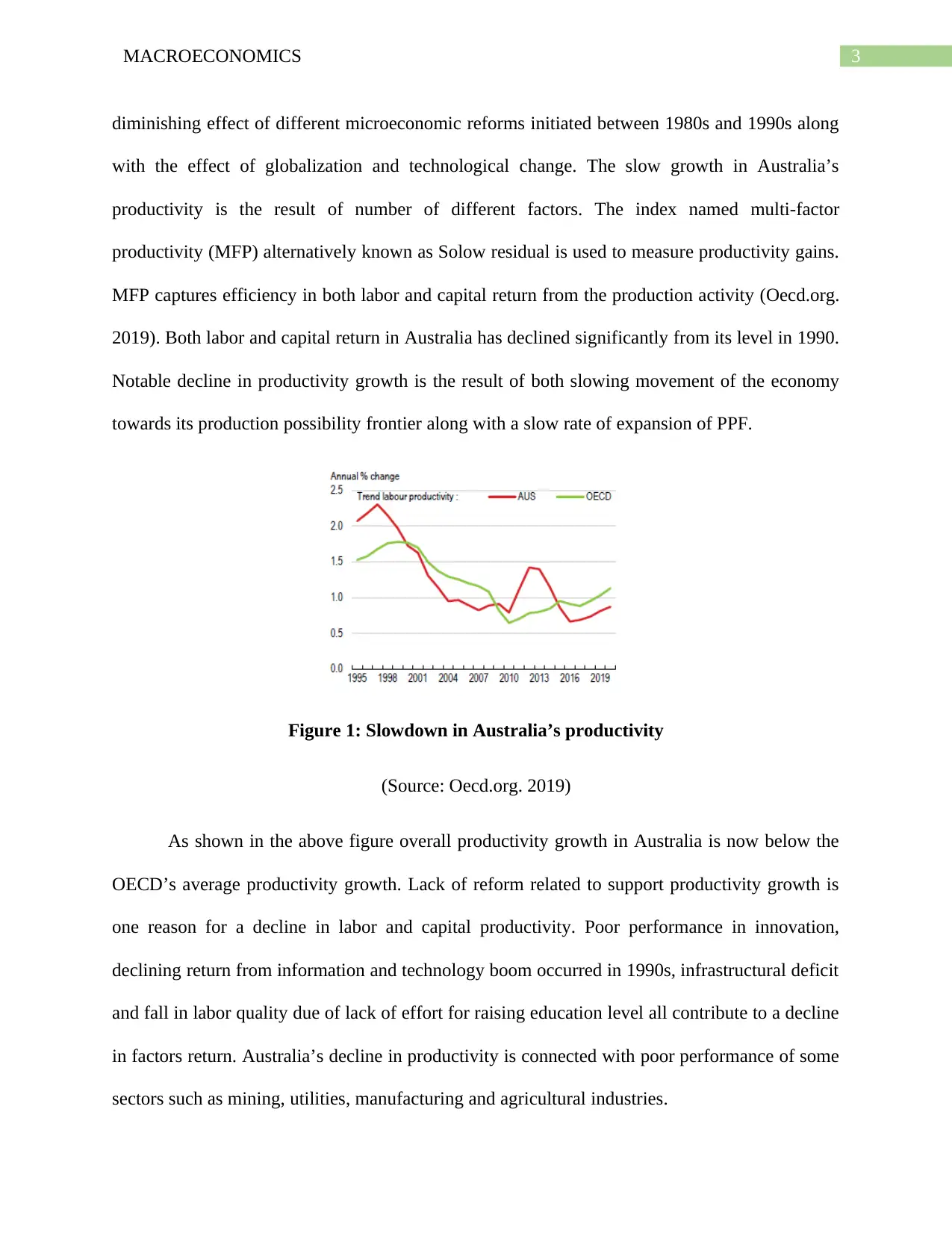
3MACROECONOMICS
diminishing effect of different microeconomic reforms initiated between 1980s and 1990s along
with the effect of globalization and technological change. The slow growth in Australia’s
productivity is the result of number of different factors. The index named multi-factor
productivity (MFP) alternatively known as Solow residual is used to measure productivity gains.
MFP captures efficiency in both labor and capital return from the production activity (Oecd.org.
2019). Both labor and capital return in Australia has declined significantly from its level in 1990.
Notable decline in productivity growth is the result of both slowing movement of the economy
towards its production possibility frontier along with a slow rate of expansion of PPF.
Figure 1: Slowdown in Australia’s productivity
(Source: Oecd.org. 2019)
As shown in the above figure overall productivity growth in Australia is now below the
OECD’s average productivity growth. Lack of reform related to support productivity growth is
one reason for a decline in labor and capital productivity. Poor performance in innovation,
declining return from information and technology boom occurred in 1990s, infrastructural deficit
and fall in labor quality due of lack of effort for raising education level all contribute to a decline
in factors return. Australia’s decline in productivity is connected with poor performance of some
sectors such as mining, utilities, manufacturing and agricultural industries.
diminishing effect of different microeconomic reforms initiated between 1980s and 1990s along
with the effect of globalization and technological change. The slow growth in Australia’s
productivity is the result of number of different factors. The index named multi-factor
productivity (MFP) alternatively known as Solow residual is used to measure productivity gains.
MFP captures efficiency in both labor and capital return from the production activity (Oecd.org.
2019). Both labor and capital return in Australia has declined significantly from its level in 1990.
Notable decline in productivity growth is the result of both slowing movement of the economy
towards its production possibility frontier along with a slow rate of expansion of PPF.
Figure 1: Slowdown in Australia’s productivity
(Source: Oecd.org. 2019)
As shown in the above figure overall productivity growth in Australia is now below the
OECD’s average productivity growth. Lack of reform related to support productivity growth is
one reason for a decline in labor and capital productivity. Poor performance in innovation,
declining return from information and technology boom occurred in 1990s, infrastructural deficit
and fall in labor quality due of lack of effort for raising education level all contribute to a decline
in factors return. Australia’s decline in productivity is connected with poor performance of some
sectors such as mining, utilities, manufacturing and agricultural industries.
Secure Best Marks with AI Grader
Need help grading? Try our AI Grader for instant feedback on your assignments.
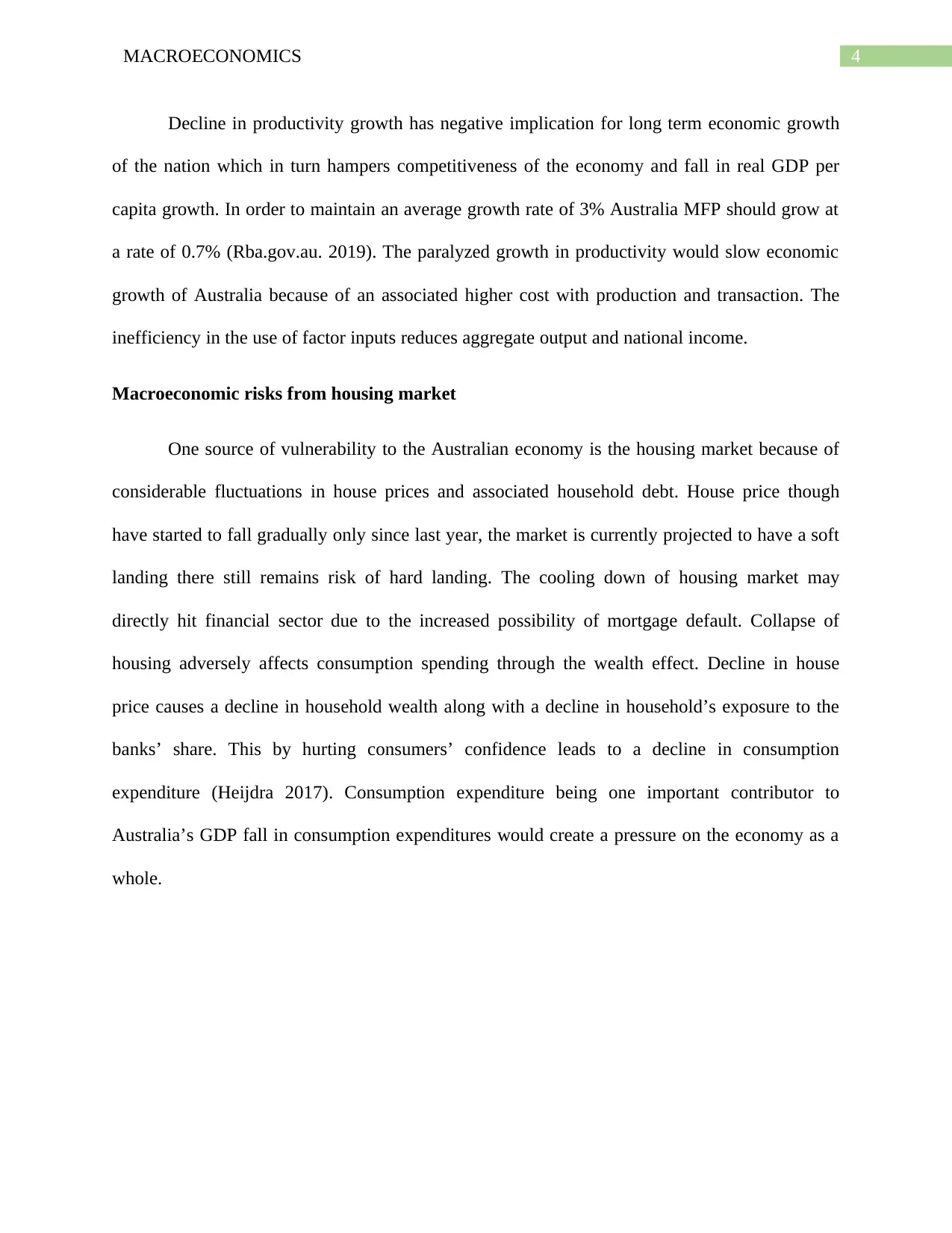
4MACROECONOMICS
Decline in productivity growth has negative implication for long term economic growth
of the nation which in turn hampers competitiveness of the economy and fall in real GDP per
capita growth. In order to maintain an average growth rate of 3% Australia MFP should grow at
a rate of 0.7% (Rba.gov.au. 2019). The paralyzed growth in productivity would slow economic
growth of Australia because of an associated higher cost with production and transaction. The
inefficiency in the use of factor inputs reduces aggregate output and national income.
Macroeconomic risks from housing market
One source of vulnerability to the Australian economy is the housing market because of
considerable fluctuations in house prices and associated household debt. House price though
have started to fall gradually only since last year, the market is currently projected to have a soft
landing there still remains risk of hard landing. The cooling down of housing market may
directly hit financial sector due to the increased possibility of mortgage default. Collapse of
housing adversely affects consumption spending through the wealth effect. Decline in house
price causes a decline in household wealth along with a decline in household’s exposure to the
banks’ share. This by hurting consumers’ confidence leads to a decline in consumption
expenditure (Heijdra 2017). Consumption expenditure being one important contributor to
Australia’s GDP fall in consumption expenditures would create a pressure on the economy as a
whole.
Decline in productivity growth has negative implication for long term economic growth
of the nation which in turn hampers competitiveness of the economy and fall in real GDP per
capita growth. In order to maintain an average growth rate of 3% Australia MFP should grow at
a rate of 0.7% (Rba.gov.au. 2019). The paralyzed growth in productivity would slow economic
growth of Australia because of an associated higher cost with production and transaction. The
inefficiency in the use of factor inputs reduces aggregate output and national income.
Macroeconomic risks from housing market
One source of vulnerability to the Australian economy is the housing market because of
considerable fluctuations in house prices and associated household debt. House price though
have started to fall gradually only since last year, the market is currently projected to have a soft
landing there still remains risk of hard landing. The cooling down of housing market may
directly hit financial sector due to the increased possibility of mortgage default. Collapse of
housing adversely affects consumption spending through the wealth effect. Decline in house
price causes a decline in household wealth along with a decline in household’s exposure to the
banks’ share. This by hurting consumers’ confidence leads to a decline in consumption
expenditure (Heijdra 2017). Consumption expenditure being one important contributor to
Australia’s GDP fall in consumption expenditures would create a pressure on the economy as a
whole.
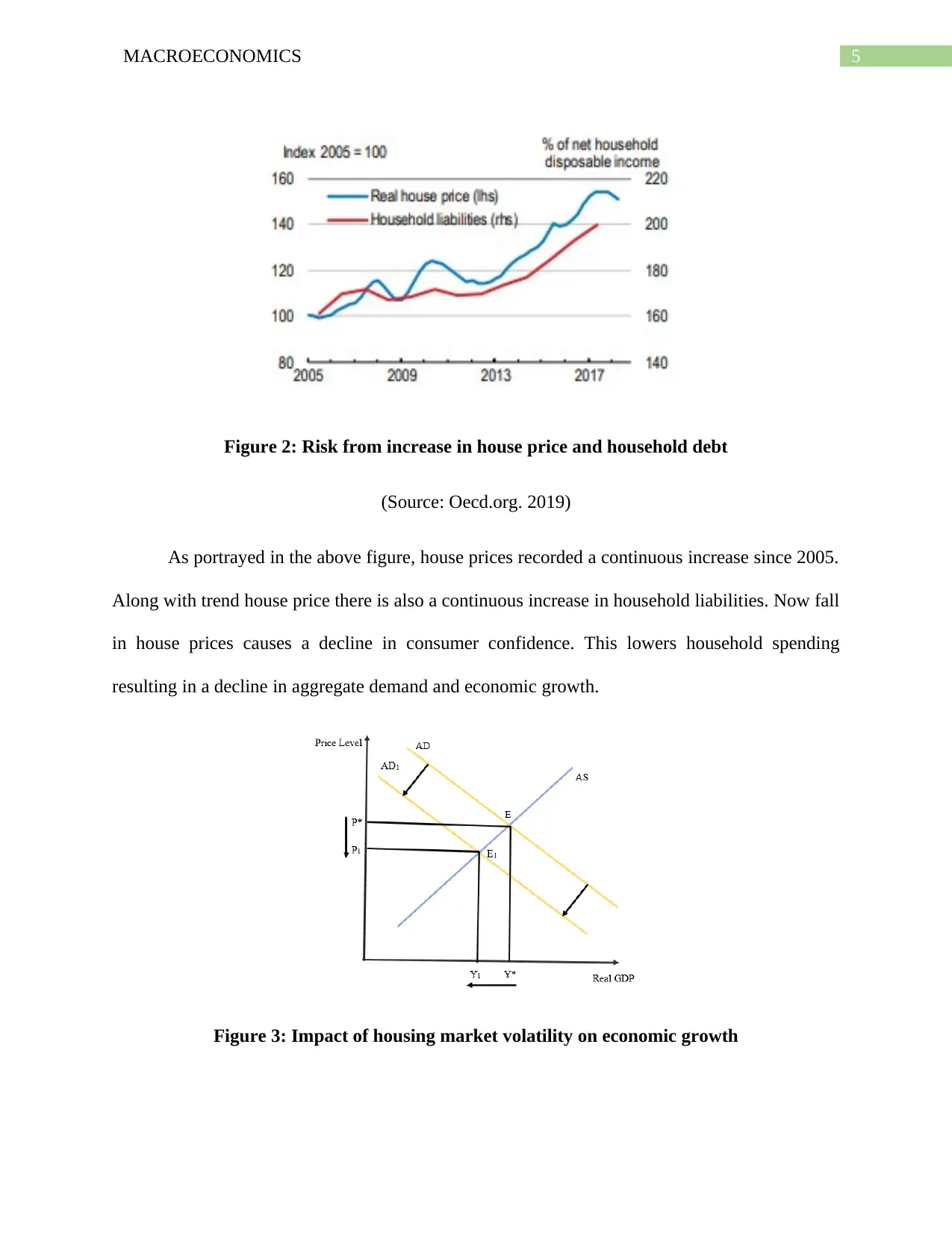
5MACROECONOMICS
Figure 2: Risk from increase in house price and household debt
(Source: Oecd.org. 2019)
As portrayed in the above figure, house prices recorded a continuous increase since 2005.
Along with trend house price there is also a continuous increase in household liabilities. Now fall
in house prices causes a decline in consumer confidence. This lowers household spending
resulting in a decline in aggregate demand and economic growth.
Figure 3: Impact of housing market volatility on economic growth
Figure 2: Risk from increase in house price and household debt
(Source: Oecd.org. 2019)
As portrayed in the above figure, house prices recorded a continuous increase since 2005.
Along with trend house price there is also a continuous increase in household liabilities. Now fall
in house prices causes a decline in consumer confidence. This lowers household spending
resulting in a decline in aggregate demand and economic growth.
Figure 3: Impact of housing market volatility on economic growth
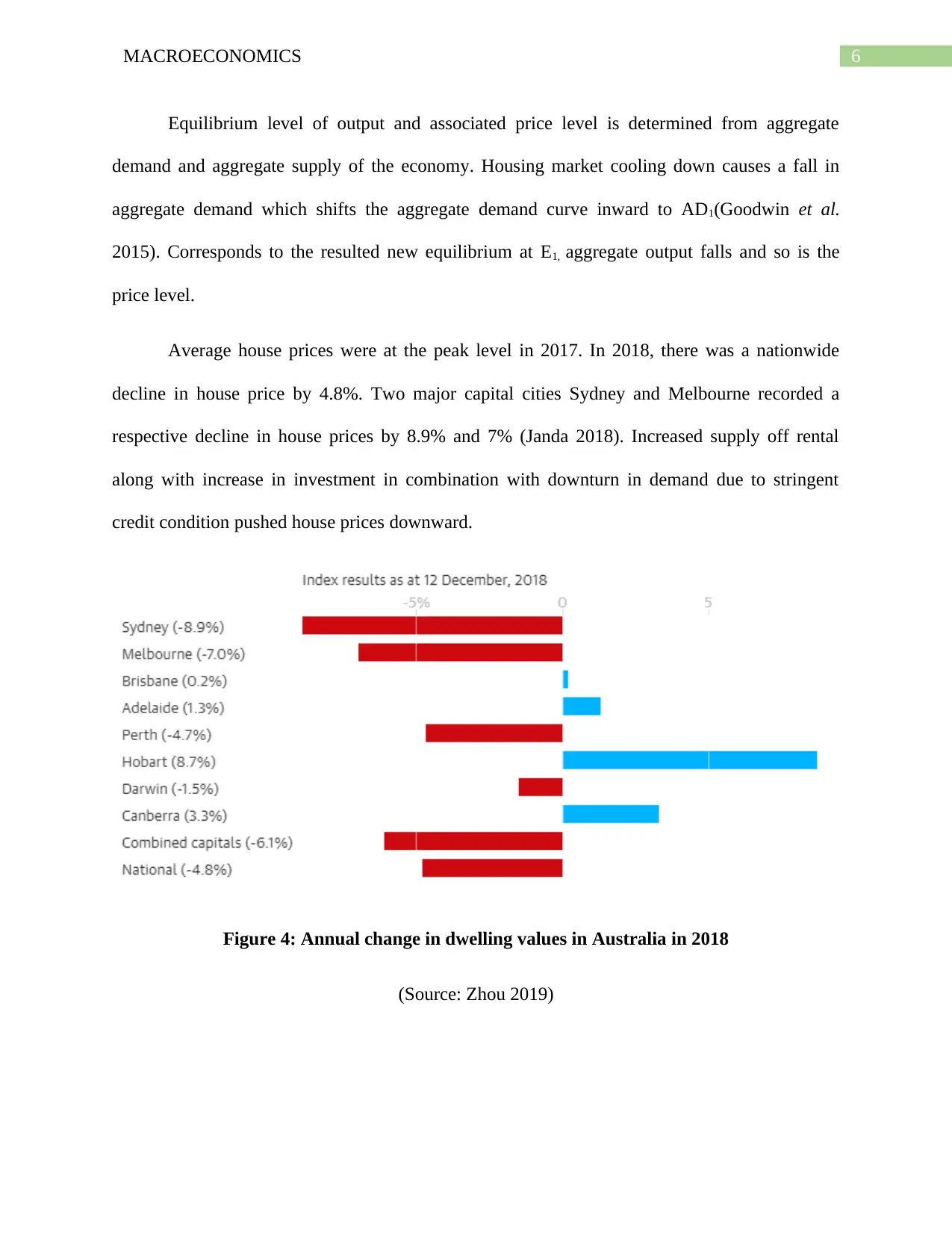
6MACROECONOMICS
Equilibrium level of output and associated price level is determined from aggregate
demand and aggregate supply of the economy. Housing market cooling down causes a fall in
aggregate demand which shifts the aggregate demand curve inward to AD1(Goodwin et al.
2015). Corresponds to the resulted new equilibrium at E1, aggregate output falls and so is the
price level.
Average house prices were at the peak level in 2017. In 2018, there was a nationwide
decline in house price by 4.8%. Two major capital cities Sydney and Melbourne recorded a
respective decline in house prices by 8.9% and 7% (Janda 2018). Increased supply off rental
along with increase in investment in combination with downturn in demand due to stringent
credit condition pushed house prices downward.
Figure 4: Annual change in dwelling values in Australia in 2018
(Source: Zhou 2019)
Equilibrium level of output and associated price level is determined from aggregate
demand and aggregate supply of the economy. Housing market cooling down causes a fall in
aggregate demand which shifts the aggregate demand curve inward to AD1(Goodwin et al.
2015). Corresponds to the resulted new equilibrium at E1, aggregate output falls and so is the
price level.
Average house prices were at the peak level in 2017. In 2018, there was a nationwide
decline in house price by 4.8%. Two major capital cities Sydney and Melbourne recorded a
respective decline in house prices by 8.9% and 7% (Janda 2018). Increased supply off rental
along with increase in investment in combination with downturn in demand due to stringent
credit condition pushed house prices downward.
Figure 4: Annual change in dwelling values in Australia in 2018
(Source: Zhou 2019)
Paraphrase This Document
Need a fresh take? Get an instant paraphrase of this document with our AI Paraphraser
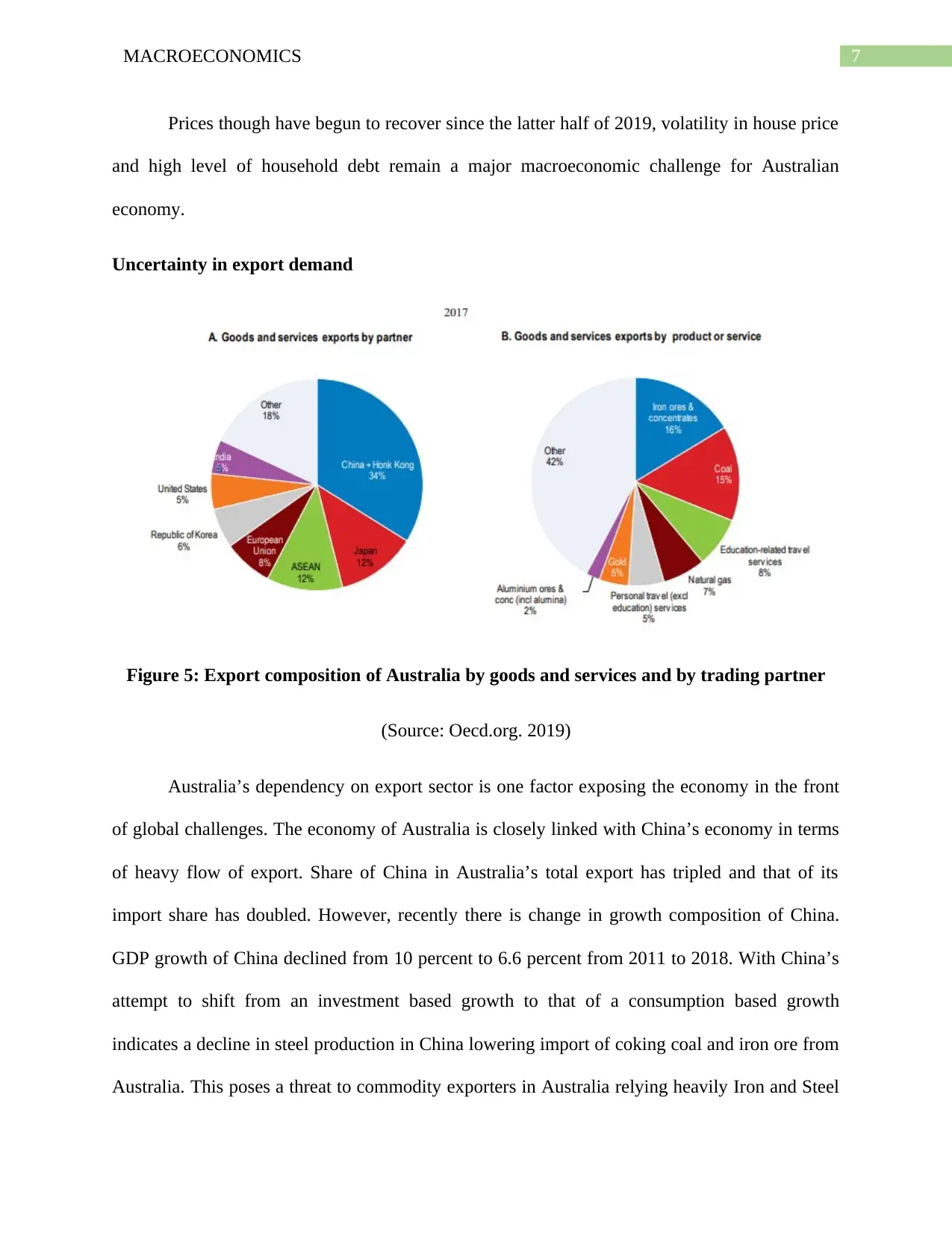
7MACROECONOMICS
Prices though have begun to recover since the latter half of 2019, volatility in house price
and high level of household debt remain a major macroeconomic challenge for Australian
economy.
Uncertainty in export demand
Figure 5: Export composition of Australia by goods and services and by trading partner
(Source: Oecd.org. 2019)
Australia’s dependency on export sector is one factor exposing the economy in the front
of global challenges. The economy of Australia is closely linked with China’s economy in terms
of heavy flow of export. Share of China in Australia’s total export has tripled and that of its
import share has doubled. However, recently there is change in growth composition of China.
GDP growth of China declined from 10 percent to 6.6 percent from 2011 to 2018. With China’s
attempt to shift from an investment based growth to that of a consumption based growth
indicates a decline in steel production in China lowering import of coking coal and iron ore from
Australia. This poses a threat to commodity exporters in Australia relying heavily Iron and Steel
Prices though have begun to recover since the latter half of 2019, volatility in house price
and high level of household debt remain a major macroeconomic challenge for Australian
economy.
Uncertainty in export demand
Figure 5: Export composition of Australia by goods and services and by trading partner
(Source: Oecd.org. 2019)
Australia’s dependency on export sector is one factor exposing the economy in the front
of global challenges. The economy of Australia is closely linked with China’s economy in terms
of heavy flow of export. Share of China in Australia’s total export has tripled and that of its
import share has doubled. However, recently there is change in growth composition of China.
GDP growth of China declined from 10 percent to 6.6 percent from 2011 to 2018. With China’s
attempt to shift from an investment based growth to that of a consumption based growth
indicates a decline in steel production in China lowering import of coking coal and iron ore from
Australia. This poses a threat to commodity exporters in Australia relying heavily Iron and Steel
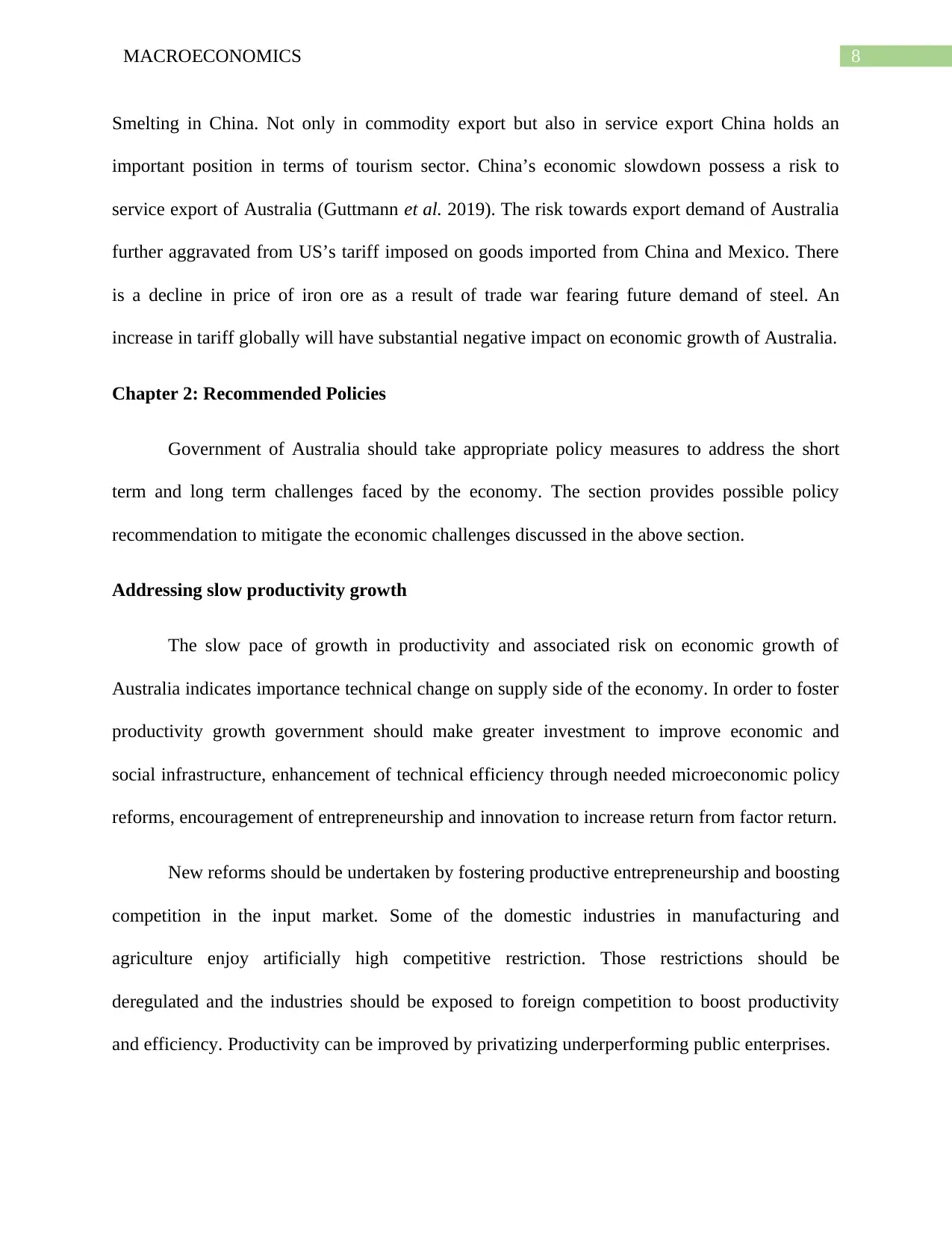
8MACROECONOMICS
Smelting in China. Not only in commodity export but also in service export China holds an
important position in terms of tourism sector. China’s economic slowdown possess a risk to
service export of Australia (Guttmann et al. 2019). The risk towards export demand of Australia
further aggravated from US’s tariff imposed on goods imported from China and Mexico. There
is a decline in price of iron ore as a result of trade war fearing future demand of steel. An
increase in tariff globally will have substantial negative impact on economic growth of Australia.
Chapter 2: Recommended Policies
Government of Australia should take appropriate policy measures to address the short
term and long term challenges faced by the economy. The section provides possible policy
recommendation to mitigate the economic challenges discussed in the above section.
Addressing slow productivity growth
The slow pace of growth in productivity and associated risk on economic growth of
Australia indicates importance technical change on supply side of the economy. In order to foster
productivity growth government should make greater investment to improve economic and
social infrastructure, enhancement of technical efficiency through needed microeconomic policy
reforms, encouragement of entrepreneurship and innovation to increase return from factor return.
New reforms should be undertaken by fostering productive entrepreneurship and boosting
competition in the input market. Some of the domestic industries in manufacturing and
agriculture enjoy artificially high competitive restriction. Those restrictions should be
deregulated and the industries should be exposed to foreign competition to boost productivity
and efficiency. Productivity can be improved by privatizing underperforming public enterprises.
Smelting in China. Not only in commodity export but also in service export China holds an
important position in terms of tourism sector. China’s economic slowdown possess a risk to
service export of Australia (Guttmann et al. 2019). The risk towards export demand of Australia
further aggravated from US’s tariff imposed on goods imported from China and Mexico. There
is a decline in price of iron ore as a result of trade war fearing future demand of steel. An
increase in tariff globally will have substantial negative impact on economic growth of Australia.
Chapter 2: Recommended Policies
Government of Australia should take appropriate policy measures to address the short
term and long term challenges faced by the economy. The section provides possible policy
recommendation to mitigate the economic challenges discussed in the above section.
Addressing slow productivity growth
The slow pace of growth in productivity and associated risk on economic growth of
Australia indicates importance technical change on supply side of the economy. In order to foster
productivity growth government should make greater investment to improve economic and
social infrastructure, enhancement of technical efficiency through needed microeconomic policy
reforms, encouragement of entrepreneurship and innovation to increase return from factor return.
New reforms should be undertaken by fostering productive entrepreneurship and boosting
competition in the input market. Some of the domestic industries in manufacturing and
agriculture enjoy artificially high competitive restriction. Those restrictions should be
deregulated and the industries should be exposed to foreign competition to boost productivity
and efficiency. Productivity can be improved by privatizing underperforming public enterprises.
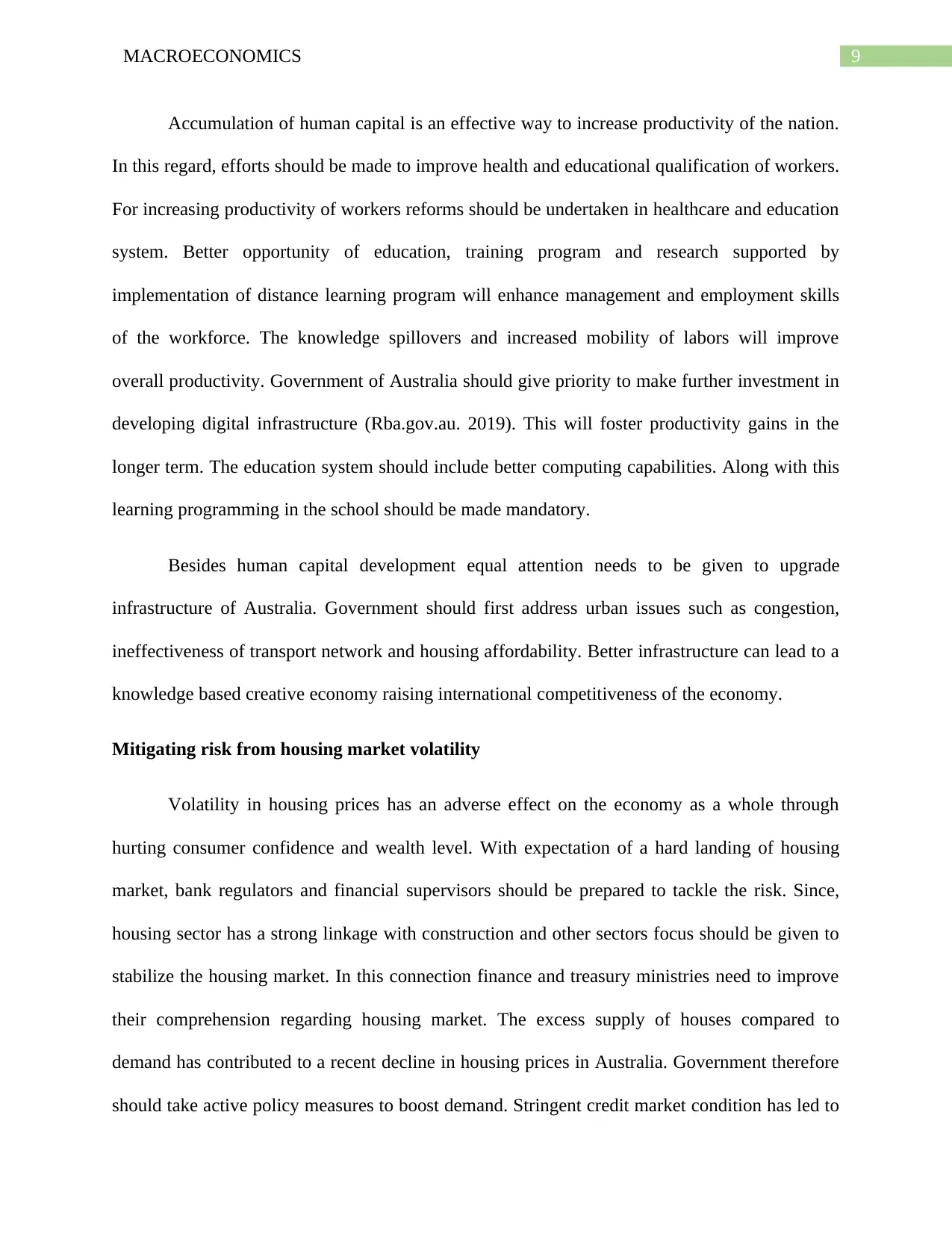
9MACROECONOMICS
Accumulation of human capital is an effective way to increase productivity of the nation.
In this regard, efforts should be made to improve health and educational qualification of workers.
For increasing productivity of workers reforms should be undertaken in healthcare and education
system. Better opportunity of education, training program and research supported by
implementation of distance learning program will enhance management and employment skills
of the workforce. The knowledge spillovers and increased mobility of labors will improve
overall productivity. Government of Australia should give priority to make further investment in
developing digital infrastructure (Rba.gov.au. 2019). This will foster productivity gains in the
longer term. The education system should include better computing capabilities. Along with this
learning programming in the school should be made mandatory.
Besides human capital development equal attention needs to be given to upgrade
infrastructure of Australia. Government should first address urban issues such as congestion,
ineffectiveness of transport network and housing affordability. Better infrastructure can lead to a
knowledge based creative economy raising international competitiveness of the economy.
Mitigating risk from housing market volatility
Volatility in housing prices has an adverse effect on the economy as a whole through
hurting consumer confidence and wealth level. With expectation of a hard landing of housing
market, bank regulators and financial supervisors should be prepared to tackle the risk. Since,
housing sector has a strong linkage with construction and other sectors focus should be given to
stabilize the housing market. In this connection finance and treasury ministries need to improve
their comprehension regarding housing market. The excess supply of houses compared to
demand has contributed to a recent decline in housing prices in Australia. Government therefore
should take active policy measures to boost demand. Stringent credit market condition has led to
Accumulation of human capital is an effective way to increase productivity of the nation.
In this regard, efforts should be made to improve health and educational qualification of workers.
For increasing productivity of workers reforms should be undertaken in healthcare and education
system. Better opportunity of education, training program and research supported by
implementation of distance learning program will enhance management and employment skills
of the workforce. The knowledge spillovers and increased mobility of labors will improve
overall productivity. Government of Australia should give priority to make further investment in
developing digital infrastructure (Rba.gov.au. 2019). This will foster productivity gains in the
longer term. The education system should include better computing capabilities. Along with this
learning programming in the school should be made mandatory.
Besides human capital development equal attention needs to be given to upgrade
infrastructure of Australia. Government should first address urban issues such as congestion,
ineffectiveness of transport network and housing affordability. Better infrastructure can lead to a
knowledge based creative economy raising international competitiveness of the economy.
Mitigating risk from housing market volatility
Volatility in housing prices has an adverse effect on the economy as a whole through
hurting consumer confidence and wealth level. With expectation of a hard landing of housing
market, bank regulators and financial supervisors should be prepared to tackle the risk. Since,
housing sector has a strong linkage with construction and other sectors focus should be given to
stabilize the housing market. In this connection finance and treasury ministries need to improve
their comprehension regarding housing market. The excess supply of houses compared to
demand has contributed to a recent decline in housing prices in Australia. Government therefore
should take active policy measures to boost demand. Stringent credit market condition has led to
Secure Best Marks with AI Grader
Need help grading? Try our AI Grader for instant feedback on your assignments.
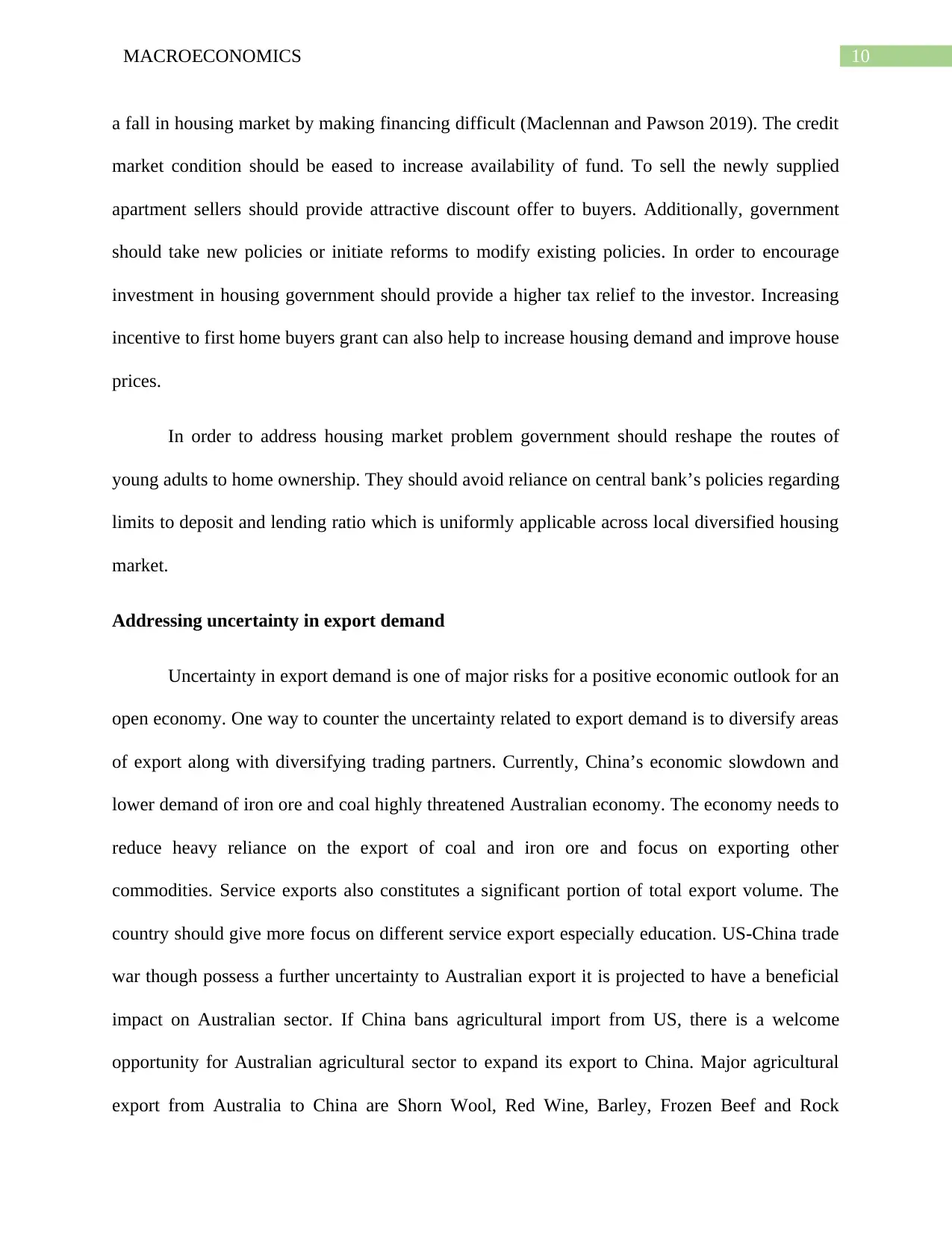
10MACROECONOMICS
a fall in housing market by making financing difficult (Maclennan and Pawson 2019). The credit
market condition should be eased to increase availability of fund. To sell the newly supplied
apartment sellers should provide attractive discount offer to buyers. Additionally, government
should take new policies or initiate reforms to modify existing policies. In order to encourage
investment in housing government should provide a higher tax relief to the investor. Increasing
incentive to first home buyers grant can also help to increase housing demand and improve house
prices.
In order to address housing market problem government should reshape the routes of
young adults to home ownership. They should avoid reliance on central bank’s policies regarding
limits to deposit and lending ratio which is uniformly applicable across local diversified housing
market.
Addressing uncertainty in export demand
Uncertainty in export demand is one of major risks for a positive economic outlook for an
open economy. One way to counter the uncertainty related to export demand is to diversify areas
of export along with diversifying trading partners. Currently, China’s economic slowdown and
lower demand of iron ore and coal highly threatened Australian economy. The economy needs to
reduce heavy reliance on the export of coal and iron ore and focus on exporting other
commodities. Service exports also constitutes a significant portion of total export volume. The
country should give more focus on different service export especially education. US-China trade
war though possess a further uncertainty to Australian export it is projected to have a beneficial
impact on Australian sector. If China bans agricultural import from US, there is a welcome
opportunity for Australian agricultural sector to expand its export to China. Major agricultural
export from Australia to China are Shorn Wool, Red Wine, Barley, Frozen Beef and Rock
a fall in housing market by making financing difficult (Maclennan and Pawson 2019). The credit
market condition should be eased to increase availability of fund. To sell the newly supplied
apartment sellers should provide attractive discount offer to buyers. Additionally, government
should take new policies or initiate reforms to modify existing policies. In order to encourage
investment in housing government should provide a higher tax relief to the investor. Increasing
incentive to first home buyers grant can also help to increase housing demand and improve house
prices.
In order to address housing market problem government should reshape the routes of
young adults to home ownership. They should avoid reliance on central bank’s policies regarding
limits to deposit and lending ratio which is uniformly applicable across local diversified housing
market.
Addressing uncertainty in export demand
Uncertainty in export demand is one of major risks for a positive economic outlook for an
open economy. One way to counter the uncertainty related to export demand is to diversify areas
of export along with diversifying trading partners. Currently, China’s economic slowdown and
lower demand of iron ore and coal highly threatened Australian economy. The economy needs to
reduce heavy reliance on the export of coal and iron ore and focus on exporting other
commodities. Service exports also constitutes a significant portion of total export volume. The
country should give more focus on different service export especially education. US-China trade
war though possess a further uncertainty to Australian export it is projected to have a beneficial
impact on Australian sector. If China bans agricultural import from US, there is a welcome
opportunity for Australian agricultural sector to expand its export to China. Major agricultural
export from Australia to China are Shorn Wool, Red Wine, Barley, Frozen Beef and Rock
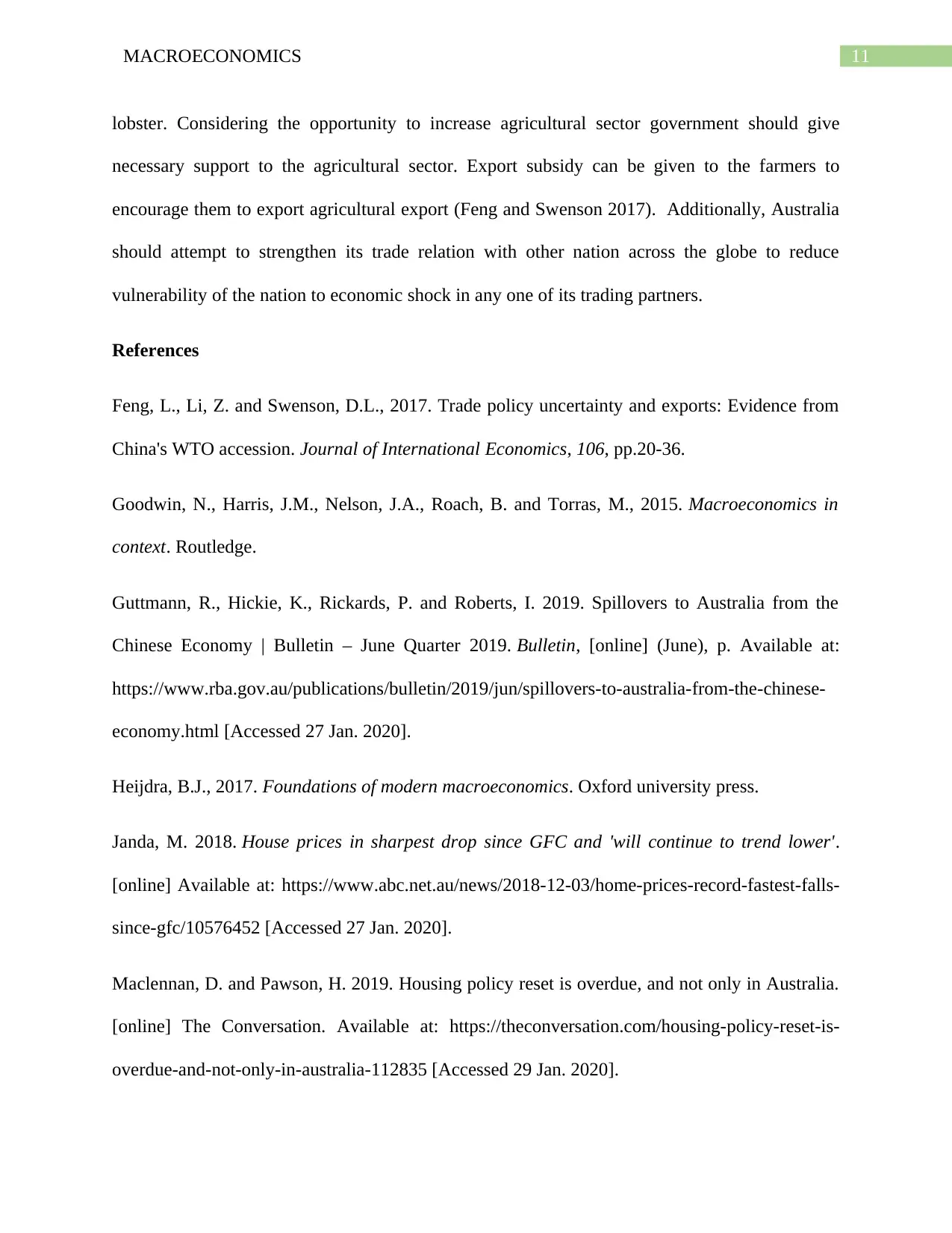
11MACROECONOMICS
lobster. Considering the opportunity to increase agricultural sector government should give
necessary support to the agricultural sector. Export subsidy can be given to the farmers to
encourage them to export agricultural export (Feng and Swenson 2017). Additionally, Australia
should attempt to strengthen its trade relation with other nation across the globe to reduce
vulnerability of the nation to economic shock in any one of its trading partners.
References
Feng, L., Li, Z. and Swenson, D.L., 2017. Trade policy uncertainty and exports: Evidence from
China's WTO accession. Journal of International Economics, 106, pp.20-36.
Goodwin, N., Harris, J.M., Nelson, J.A., Roach, B. and Torras, M., 2015. Macroeconomics in
context. Routledge.
Guttmann, R., Hickie, K., Rickards, P. and Roberts, I. 2019. Spillovers to Australia from the
Chinese Economy | Bulletin – June Quarter 2019. Bulletin, [online] (June), p. Available at:
https://www.rba.gov.au/publications/bulletin/2019/jun/spillovers-to-australia-from-the-chinese-
economy.html [Accessed 27 Jan. 2020].
Heijdra, B.J., 2017. Foundations of modern macroeconomics. Oxford university press.
Janda, M. 2018. House prices in sharpest drop since GFC and 'will continue to trend lower'.
[online] Available at: https://www.abc.net.au/news/2018-12-03/home-prices-record-fastest-falls-
since-gfc/10576452 [Accessed 27 Jan. 2020].
Maclennan, D. and Pawson, H. 2019. Housing policy reset is overdue, and not only in Australia.
[online] The Conversation. Available at: https://theconversation.com/housing-policy-reset-is-
overdue-and-not-only-in-australia-112835 [Accessed 29 Jan. 2020].
lobster. Considering the opportunity to increase agricultural sector government should give
necessary support to the agricultural sector. Export subsidy can be given to the farmers to
encourage them to export agricultural export (Feng and Swenson 2017). Additionally, Australia
should attempt to strengthen its trade relation with other nation across the globe to reduce
vulnerability of the nation to economic shock in any one of its trading partners.
References
Feng, L., Li, Z. and Swenson, D.L., 2017. Trade policy uncertainty and exports: Evidence from
China's WTO accession. Journal of International Economics, 106, pp.20-36.
Goodwin, N., Harris, J.M., Nelson, J.A., Roach, B. and Torras, M., 2015. Macroeconomics in
context. Routledge.
Guttmann, R., Hickie, K., Rickards, P. and Roberts, I. 2019. Spillovers to Australia from the
Chinese Economy | Bulletin – June Quarter 2019. Bulletin, [online] (June), p. Available at:
https://www.rba.gov.au/publications/bulletin/2019/jun/spillovers-to-australia-from-the-chinese-
economy.html [Accessed 27 Jan. 2020].
Heijdra, B.J., 2017. Foundations of modern macroeconomics. Oxford university press.
Janda, M. 2018. House prices in sharpest drop since GFC and 'will continue to trend lower'.
[online] Available at: https://www.abc.net.au/news/2018-12-03/home-prices-record-fastest-falls-
since-gfc/10576452 [Accessed 27 Jan. 2020].
Maclennan, D. and Pawson, H. 2019. Housing policy reset is overdue, and not only in Australia.
[online] The Conversation. Available at: https://theconversation.com/housing-policy-reset-is-
overdue-and-not-only-in-australia-112835 [Accessed 29 Jan. 2020].
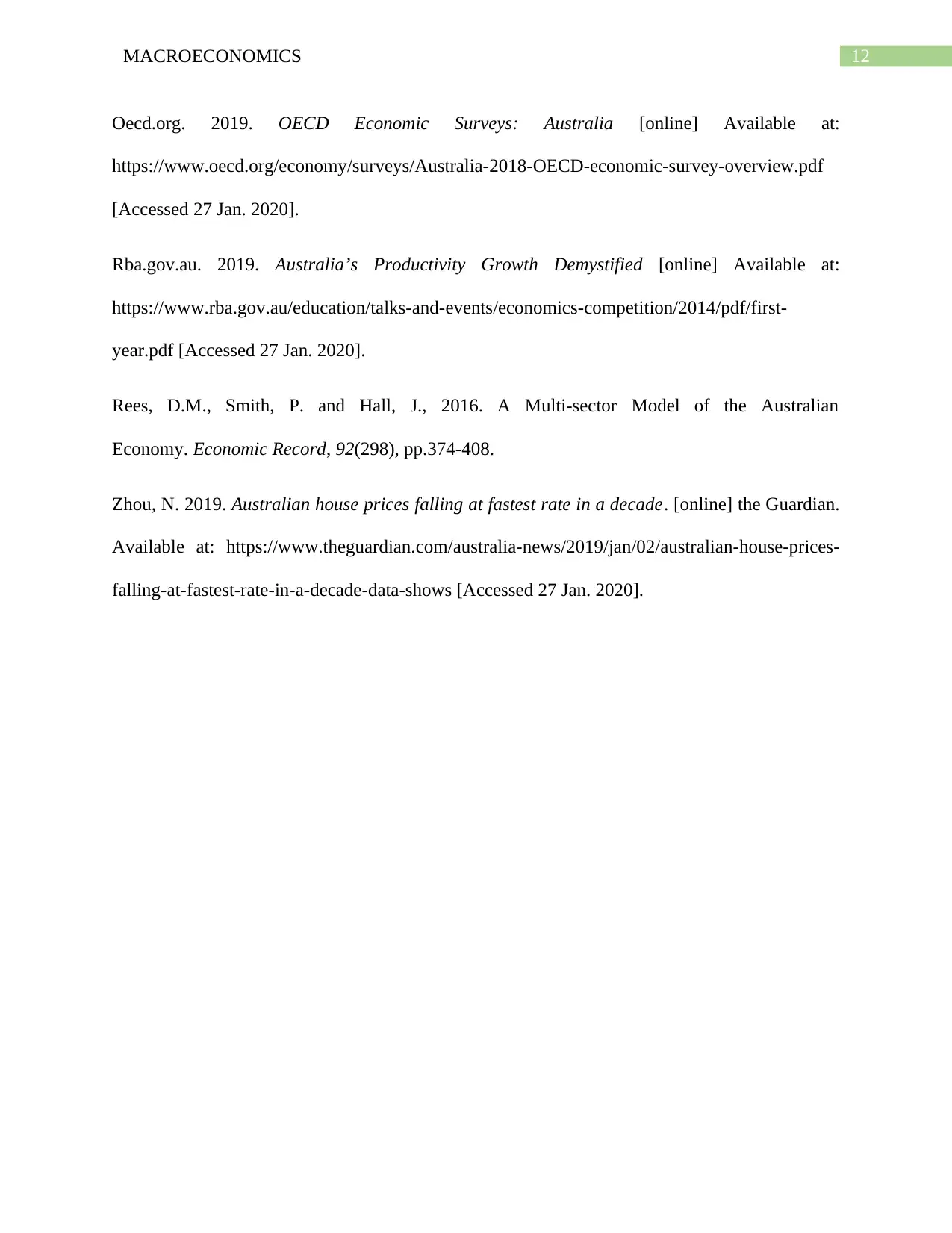
12MACROECONOMICS
Oecd.org. 2019. OECD Economic Surveys: Australia [online] Available at:
https://www.oecd.org/economy/surveys/Australia-2018-OECD-economic-survey-overview.pdf
[Accessed 27 Jan. 2020].
Rba.gov.au. 2019. Australia’s Productivity Growth Demystified [online] Available at:
https://www.rba.gov.au/education/talks-and-events/economics-competition/2014/pdf/first-
year.pdf [Accessed 27 Jan. 2020].
Rees, D.M., Smith, P. and Hall, J., 2016. A Multi‐sector Model of the Australian
Economy. Economic Record, 92(298), pp.374-408.
Zhou, N. 2019. Australian house prices falling at fastest rate in a decade. [online] the Guardian.
Available at: https://www.theguardian.com/australia-news/2019/jan/02/australian-house-prices-
falling-at-fastest-rate-in-a-decade-data-shows [Accessed 27 Jan. 2020].
Oecd.org. 2019. OECD Economic Surveys: Australia [online] Available at:
https://www.oecd.org/economy/surveys/Australia-2018-OECD-economic-survey-overview.pdf
[Accessed 27 Jan. 2020].
Rba.gov.au. 2019. Australia’s Productivity Growth Demystified [online] Available at:
https://www.rba.gov.au/education/talks-and-events/economics-competition/2014/pdf/first-
year.pdf [Accessed 27 Jan. 2020].
Rees, D.M., Smith, P. and Hall, J., 2016. A Multi‐sector Model of the Australian
Economy. Economic Record, 92(298), pp.374-408.
Zhou, N. 2019. Australian house prices falling at fastest rate in a decade. [online] the Guardian.
Available at: https://www.theguardian.com/australia-news/2019/jan/02/australian-house-prices-
falling-at-fastest-rate-in-a-decade-data-shows [Accessed 27 Jan. 2020].
1 out of 13
Related Documents
Your All-in-One AI-Powered Toolkit for Academic Success.
+13062052269
info@desklib.com
Available 24*7 on WhatsApp / Email
![[object Object]](/_next/static/media/star-bottom.7253800d.svg)
Unlock your academic potential
© 2024 | Zucol Services PVT LTD | All rights reserved.





